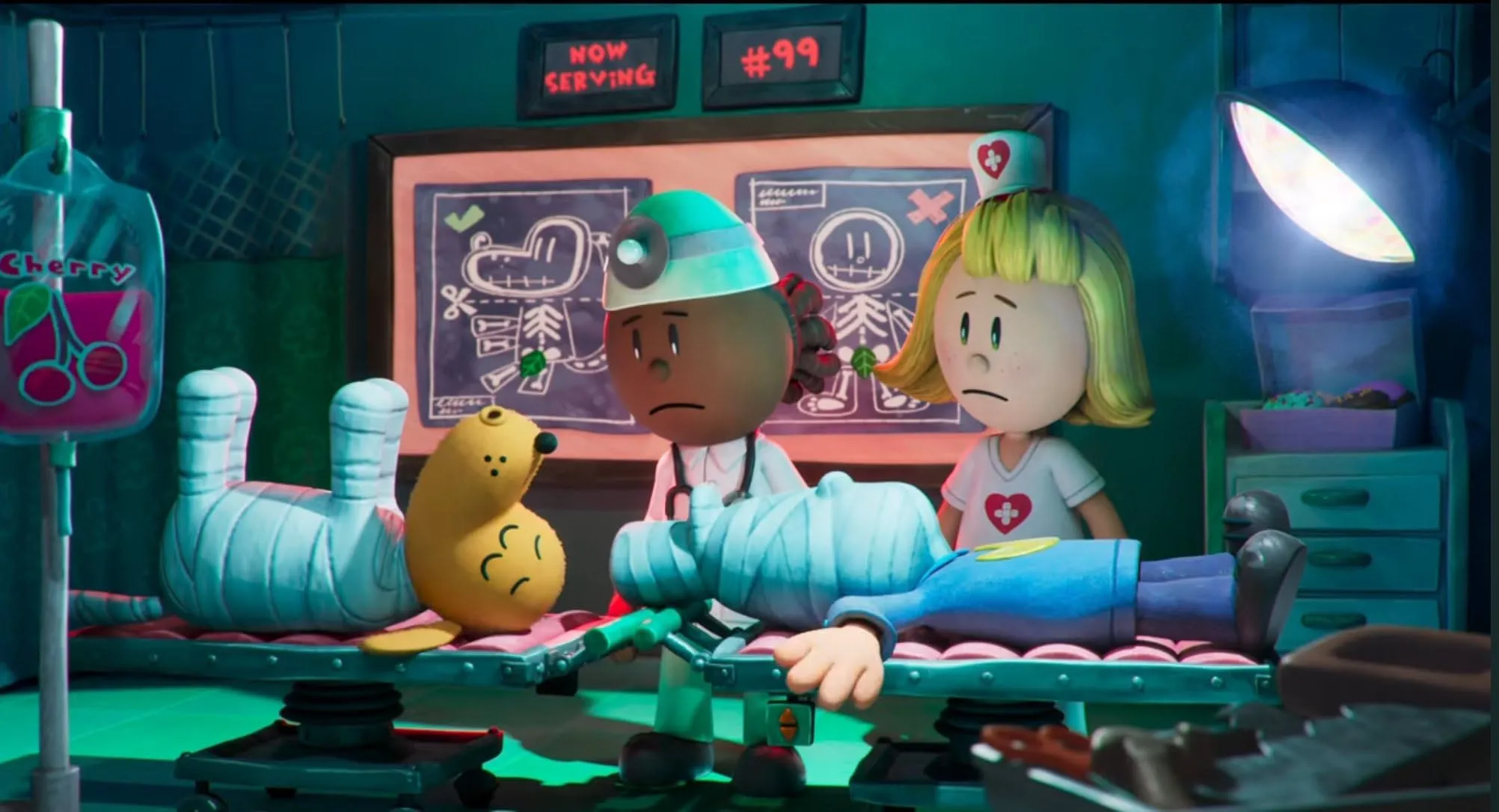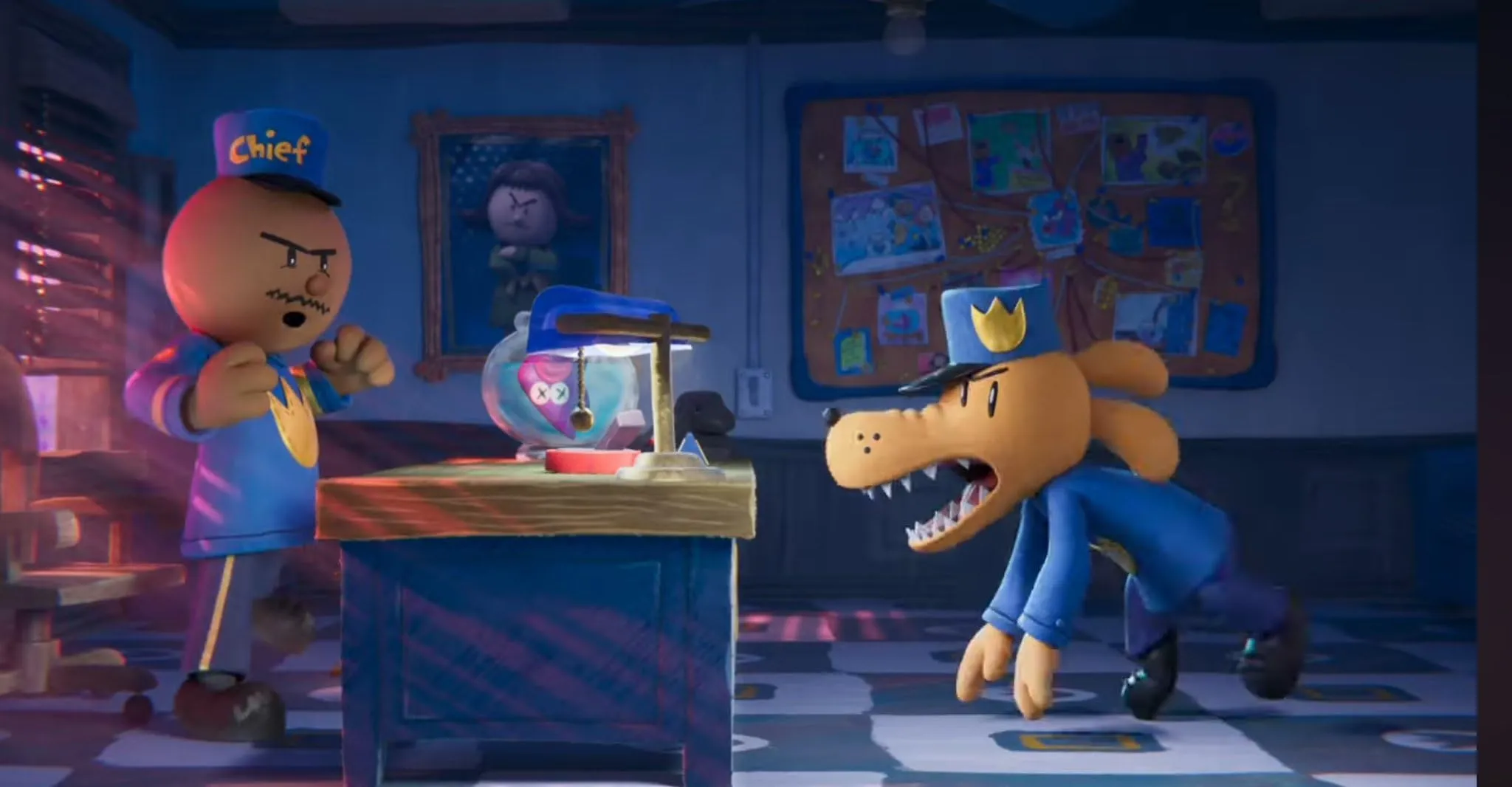The unbridled excitement of Dog Man stems from its rejection of traditional storytelling limits. DreamWorks Animation captures Dav Pilkey’s children’s series with wild energy, creating a film bursting with visual chaos and narrative freedom. Peter Hastings directs a work that embraces pure silliness, transforming what could be overwhelming into something truly exciting.
Dog Man opens with a blend of zany humor and genuine emotion. Set in Ohkay City, a world where rules bend and twist, the story follows a character born from medical creativity—part human, part dog. This hero moves with the unfiltered excitement of a child’s imaginative sketch, leaping through adventures that prioritize humor over logic. Action sequences race with comedic momentum, embodying pure childhood creativity: wild, unconstrained, and gloriously messy.
The film goes beyond simple comedy. Its rapid jokes and physical comedy carry emotional depth. While children will delight in its goofy spirit, subtle humor and heartfelt character moments keep older viewers interested. Dog Man understands that playful storytelling can create meaningful connections, delivering unexpected warmth within its crazy, barking world.
The Aesthetic Anarchy of Dog Man
Controlled chaos requires skill, and Dog Man masters this approach. DreamWorks Animation creates an animated world that shuns technical perfection, instead celebrating the wild creativity of childhood imagination. The film embraces a crayon-textured style that treats visual sophistication as unnecessary. Where other animations seek perfect details, Dog Man chooses raw energy and playful expression.
Characters move with intentional awkwardness, reminiscent of hand-drawn stop-motion animations. Their movements feel spontaneous and unrefined, as if sketched directly onto the screen. Each frame bursts with unpredictable life, like a flipbook suddenly animated. This approach challenges traditional animation techniques, prioritizing spirit over smoothness.
Vibrant colors explode across the screen—electric primaries and bold hues fight for attention. Dog Man’s soft texture contrasts with Petey’s crayon-like fur, creating a world pulled straight from a child’s sketchbook. Explosions become whimsical swirls instead of standard fireballs. Text appears in jagged, enthusiastic lettering, turning the entire visual experience into a living comic strip.
Petey’s expressions reveal hidden emotional depth. Wide, angular eyes shift between smug indifference and unexpected vulnerability. Despite the visual chaos, these subtle moments create quiet pockets of genuine feeling—a testament to the film’s artistic vision.
The Chaos and Compassion of Dog Man
A medical absurdity sparks Dog Man’s story. The film charges forward without questioning its own logic, treating wild scenarios as absolute truth. After a bomb injures a police officer and his dog, a surgeon’s unusual decision creates an unexpected hero. The narrative philosophy emerges quickly: strange ideas can carry emotional weight.
Petey, a self-proclaimed villain, becomes the story’s center. His failed schemes and scientific mishaps reveal a deeper struggle. Lil’ Petey, his unexpected clone, sees past Petey’s criminal exterior to a potential father figure. Wildly comic moments hide deeper explorations of connection and change.
Dog Man represents a walking contradiction—a hero blending different identities. The character becomes less important than Petey’s journey through accidental fatherhood. Trapped between protecting himself and accepting responsibility, Petey navigates unexpected emotional terrain.
The film races from scene to scene, barely pausing for reflection. Flippy, a villainous fish with a sardonic attitude, adds chaos to the already tumultuous narrative. Each moment bursts with energy, prioritizing comedy over careful storytelling.
Messy and unpolished, the film refuses to smooth its rough edges. Characters stumble toward understanding through shared experiences. Emotional truth emerges in unexpected moments, with a dog-headed hero serving as the most grounded character in a world of complete chaos.
The Beating Heart of Absurdity: Dog Man and Its Cast of Chaotic Souls
A film bending reality’s rules creates a peculiar hero. Dog Man, stitched together from impossible parts, stands as the simplest character in his own story. Peter Hastings voices this character through barks and instinctive actions—chasing, wagging, defeating villains with pure heart. His uncorruptible nature defines heroism without deep reflection. Despite being the title character, Dog Man serves as a backdrop to deeper emotional journeys.
Petey carries the story’s emotional weight. Pete Davidson voices the character with nuanced complexity, shifting between confident swagger and quiet vulnerability. Petey represents a cynical cat slowly transformed by unexpected care. Lil’ Petey, his accidental clone, brings opposite energy—bright, hopeful, believing in goodness. Lucas Hopkins Calderon gives the kitten a pure, infectious spirit. Their relationship creates the film’s true emotional core.
Supporting characters drift around the central narrative. Ricky Gervais plays Flippy, a vengeful reanimated fish, while Lil Rel Howery portrays Chief—a character wrestling with unspoken feelings for reporter Sarah Hatoff (Isla Fisher). These personalities add comic texture without deeply changing the story’s path.
Dog Man reveals emotional depth through unexpected moments. Silent characters often tell the most compelling stories, proving that heroism rarely looks exactly like we expect.
The Frenzied Symphony of Laughter: Dog Man and Its Riotous Sense of Humor
Comedy can invite and challenge audience expectations. Dog Man creates humor through childlike energy and precise execution. The film treats comedy as its core, delivering a constant stream of slapstick, wild scenarios, and self-aware jokes. Sight gags, physical comedy, wordplay, and commentary crash together with wild excitement. Each moment races toward the next punchline without pausing.
Cartoon physics drive the film’s most primal comedy. Characters leap, tumble, and crash in endless motion. Dog Man moves like an untrained golden retriever, battling between professional duty and pure animal instinct. Young viewers will delight in physical comedy, while hidden jokes reward older audiences. Clever references to classic movies and sneaky background gags show the film’s understanding of animated storytelling.
The rapid pace sometimes overwhelms emotional moments. Petey and Lil’ Petey’s story of unexpected connection struggles against the film’s breakneck speed. Genuine feeling gets pushed aside by spectacular chase scenes and wild comedy. Although Dog Man thrives on overwhelming energy, it sometimes forgets that quiet moments can make laughter more powerful.
The Velocity of Chaos: Dog Man and the Art of Relentless Motion
Dog Man moves with extreme speed, racing beyond traditional storytelling. The film charges forward like an unstoppable machine, creating a whirlwind of jokes, action, and visual madness. Its rhythm matches children’s wild imagination—a perfect storm of unfiltered energy. Viewers might feel like passengers on an uncontrolled carnival ride.
Speed creates challenges for deeper storytelling. Emotional moments between Petey and Lil’ Petey appear briefly, quickly replaced by comedic chases and explosive scenes. Subplots about Chief’s romantic interest or city corruption drift through the narrative, never fully developing before the story rushes elsewhere.
Spectacular sequences capture true cinematic magic. A battle involving living buildings erupts with inspired silliness, breaking every rule of logical storytelling. The final confrontation explodes with mischievous energy, embracing complete chaos. Dog Man exists in constant motion, rejecting quiet moments and traditional storytelling structures. Each scene builds upon the last with increasing wildness, creating a film that refuses to pause or breathe.
Unleashing the Future: Dog Man and the Promise of Playful Anarchy
Dog Man embraces total absurdity without hesitation. The film treats nonsense as both artistic expression and storytelling technique. Its world allows impossible scenarios: a hero created from two species, a talking fish plotting destruction, and redemption arriving through persistent love. Slapstick and spectacle hide deep emotional truth.
Wild energy sometimes overwhelms the narrative. Jokes and story moments crash into each other without breathing room. Subplots appear and disappear like scattered dreams. While the film’s emotional center remains strong, frantic movement often buries deeper feelings. Dog Man understands its audience but races past potentially powerful moments.
Pilkey’s universe offers rich storytelling ground. Petey’s unexpected change, Lil’ Petey’s pure hope, and Dog Man’s complex identity create space for future stories. The film exists as a wild, uncontrolled sprint through imagination—proving that ridiculous ideas can carry profound emotional weight.
The Review
Dog Man
Dog Man bursts with wild energy, capturing Dav Pilkey's book series through visual chaos and laugh-out-loud comedy. Slapstick moments blend with unexpected emotional threads. The film races with uncontrolled excitement, sometimes losing subtle character connections amid its frantic pace. Packed with imaginative scenes, the story speaks to children and grown-ups alike, creating a world where pure creativity reigns supreme.
PROS
- Bursting with energetic, inventive animation that mirrors the book’s crayon-textured style.
- Fast-paced, slapstick-heavy humor that appeals to kids, with clever meta-references for adults.
- Strong character dynamics, particularly Petey and Lil’ Petey’s emotional arc.
CONS
- Overstuffed with jokes and subplots, occasionally sacrificing emotional resonance.
- Dog Man himself is underdeveloped, with the story shifting focus to Petey’s redemption.
- Some supporting characters and side plots feel incomplete or unnecessary.





















































